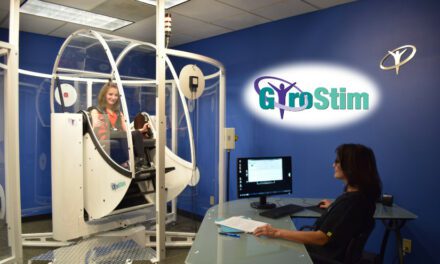The goal of this article is to highlight the elements of qigong that fit well with physical therapy – qigong for the physical therapist. A PT does not need to become an expert in qigong to start using qigong principles and exercises with patients.
By Karen Danchalski, PT, DPT
Disclaimer: I am not a master of qigong, I have never led a tai chi class, and I have let my yoga class card expire more times than I can remember. I am writing to you as a physical therapist and qigong practitioner who has found joy and purpose fusing the two modalities. I teach as I learn, my practice and teaching reinforce each other, and I often practice alongside my patients as I lead them through the exercises. A physical therapist does not need to become an expert in a particular type of qigong, have hundreds of hours of practice, or hold a certification to start using qigong principles and exercises with patients.
The goal of this article is to highlight the elements of qigong that fit well with physical therapy. It is not my intention to delve into all the principles of traditional Chinese medicine (TCM) or describe qigong in absolute detail. How can qigong help physical therapy patients? Why is a physical therapist qualified to teach qigong? How can learning qigong add to a therapist’s toolbox and enhance a patient’s therapeutic experience? These are some of the questions I intend to answer.
As discussed in my recent article The Benefits of Mindful Movement in Physical Therapy, qigong is an ancient Chinese form of exercise that combines breath and intention with mindful movement. Qi is the Chinese word for energy and gong means work. Qigong therefore means “energy work” and refers to the practice of moving energy throughout the body for health and well-being. In TCM, illness results from a disruption or blockage in the flow of qi. Although western medicine does not recognize qi as it is described in TCM, scientific evidence supports the practice of qigong in reducing pain, promoting healing, and improving physical, mental, and emotional health.
Listen to more about using mindful movement: Podcast: Mindful Movement with Karen Danchalski, PT, DPT
Physical therapists have strong foundations in body mechanics, posture, and movement. Qigong exercises practiced purely on the physical level can be thought of as light to moderate exercise. Therapists, if they choose, can focus their teaching on this physical level and introduce patients to a number of new routines for stretching, strengthening, and balance. Qigong, when taught as mindful movement, however, requires a broader understanding of TCM concepts and cues. Beyond the physical practice, there are five additional levels which differ in intention but not necessarily difficulty. Which levels are most relevant to physical therapy, and what are some specific qigong cues that can be helpful to patients? Let’s dive in.
Six Levels of Qigong Practice
Physical level (Li) is the movement or choreography of the exercise and is often taught first. The patient learns the placement of the hand, which knee to bend, or the direction of a weight shift, for example. Qigong movements are repetitive. This reinforces the motor pattern, allowing the patient to then focus on the feeling of the exercise and enter into a flow state.
Elastic level (Jing) refers to the feeling of stretch or elasticity in the soft tissues of the body. Some exercises such as “pushing the pillars – pressing the hands out to the side” or “turning the hands – alternating pronation/supination with the arms extended” create and release neural tension and look and feel quite similar to traditional physical therapy neural flossing or gliding techniques. There is a method of qigong practice called YiJin Jing or “muscle tendon changing,” which focuses on transforming and developing the elasticity and strength of the soft tissues.
Mental level (Yi) focuses on visualization and imagery to guide the movement. Imagery in qigong is usually linked to nature. Patients are cued to feel strong and powerful like they are pushing a rock, rooting their feet like trees into the ground, or floating the arms upward like ashes from a fire. Exercises typically have names like the “crane,” “emerging tiger,” or “rolling like a wave,” which characterizes the feeling and quality of the movement.
Energy level (Qi) focuses on moving stagnant Qi and improving circulation and flow of energy throughout the body. In TCM, there is the concept of yin and yang in which energy is either turned inward and restored (Yin) or moved outward and released (Yang). In TCM, there should be a balance of yin and yang energy for optimal health and well-being. Patients learn to feel sensations in the body such as warmth, tingling, changes in the breath, or release of muscle tension, which can be signs of increased Qi flow.
Spirit level (Shen) is the intention of practicing qigong at the level of one’s spirit. The shen, or “spirit,” emanates from the heart center which houses our emotions and instincts. Qigong exercises named for different animals, such as the dragon, monkey, or bear can be practiced at the shen level where the patient feels and expresses the nature of the animal. One can also practice at the Shen level when connecting to a “universal or divine” source of energy which can depend on a patient’s religious or spiritual beliefs.
Emptiness (Kong) is the intention to enter into a meditative state on the feeling of emptiness while practicing both static and moving postures. This type of practice can be highly restorative and healing but is generally more difficult to achieve. It can feel like time is standing still as patients enter into a flow state. Our busy minds and lives make it challenging to practice at this level.
I have explored Li, Jing, Yi, and Qi with my patients, as I feel these levels are most relevant to physical therapy. Below I have given a few examples of patients who I have treated successfully at various levels of practice.
Patient Examples of Qigong for the Physical Therapist
A 65-year-old man with a history of degenerative disc disease and stenosis wants to learn some new ways to stretch and loosen up his back. He also complains of stiffness in his hips and weakness in his legs. I select a hip circle and back circle warm-up in standing and the “wheel” with emphasis on pushing and pulling through the legs in a staggered stance. The focus is on the physical aspects of the exercises.
A 40-year-old female with a history of cervical radiculopathy feels tightness in her neck and in her right arm down to her hand. She complains of feeling restricted in reaching and using her right arm for doing housework and caring for her toddler. She asks if there are any exercises to loosen up the muscles in her arm. I select “pushing the pillars” with focus on good cervical alignment and “drawing the bow” for stretching through the pec and arm with gentle rotation of the neck. The focus is on the elasticity felt during the exercises.
A 70-year-old man with Parkinson’s disease complains of impaired movement, difficulty getting up from a chair, balance problems, and difficulty in turning direction while walking. He wants to learn some exercises that focus on his balance and walking. I select the “buddha walk” which is a slow side step emphasizing pressing the foot on/off the floor, and “cloud hands” which requires coordination of the hands with trunk rotation while weight shifting side to side. The focus is on the visual imagery of rooting the feet into the ground and moving the hands like they are parting the clouds.
A 55-year-old woman with a diagnosis of dermatomyositis complains of pain and restriction in her chest and neck muscles. She states she has had increased anxiety since caring for her elderly parents and sometimes feels restricted in taking a deep breath. She wants to feel like her body can move more freely. I select a routine of three different movements that release tension in the neck and shoulders named the “bear,” “parting the horse’s mane,” and emerging tiger” and end with a standing meditation with a focus on the breath and release of muscle tension. The focus is on moving energy through the body.
Directions of Movement
As therapists, we know that quality of movement matters. We talk to our patients about slowing down repetitions and controlling movements. Qigong uses specific language that can help describe the direction or quality of movement. There are seven directions of movement in qigong: upward, downward, outward, inward, turning, circling, and spiraling.
| Upward movements | Lifting, floating, pressing or pushing upward. |
| Downward movements | Grounding, settling, heavy or sinking, can be passive and gravity assisted, or active as in pressing or pushing downward. |
| Outward movements | Growing, expanding, or the feeling of “letting go” of excess energy or pain, moving from one’s center. |
| Inward movements | Pulling in, gathering, or compressing toward one’s center. |
| Turning | Rotating around the spine. Turning is performed within a patient’s comfortable range of motion. Twisting moves further into a restriction and can be used to increase mobility. |
| Circling | Making the shape of a circle with the arms, hands, hips, etc. |
| Spiraling | Non-linear, combining energies moving in different directions while feeling grounded and lifted simultaneously. Spiraling is a more complex motion to feel. |
Additional Concepts and Cues
In addition to direction and quality of movement, therapists can cue breathing and mindfulness, and impart insightful nuggets of wisdom to their patients during routines. Breathing can be slow and diaphragmatic, coordinated with movement, or cued to “just be natural.” Therapists can encourage meditation or mindfulness while working on posture. A home program could include standing for 3-5 minutes in “ready stance” or “horse’s stance.” Patients learn to focus their mind on their pelvic and spinal alignment, staying lifted through the head and neck, softening their knees, keeping their shoulders down and breathing deeply. Patients learn to feel just enough tone to maintain good posture while letting go of unnecessary muscle tension. Simultaneously they learn the benefit of taking a break from their busy day and being mindful.
Qigong can be part of a patient’s home exercise program and support the patient’s therapeutic goals. The number of repetitions, the speed of the exercise, and the level of effort will be dependent on how the patient feels at the moment and can change from one session to the next. Since the movements are gentle, they can be performed as few as 5 times or for as long as several minutes. Patients are taught the concept of “effortless effort,” which means they are fully present and focused but use about 70% physical effort to allow space for self-discovery and conserving energy.
The goal of qigong for the physical therapist or for anyone is to practice with a calm and focused mind, to become aware of the sensations of the body, and ultimately enter into a flow state. Patients are unique and will bring their former experiences and injuries to their practice. Patients should learn not to compare themselves to others or be preoccupied with making their movements look perfect. Therapists can adapt any qigong exercise to the needs of the patient by changing the position to sitting or lying down, reducing the number of components, or building one cue at a time.
I have discovered tremendous versatility in qigong and have used it with a wide variety of patients with differing diagnoses, physical and cognitive abilities, and even with patients who are non-ambulatory or bedbound. Not all patients will be receptive to learning qigong. They may not think of it as conventional exercise or may have preconceived notions about its origins. They may be uncomfortable with the stillness and patience required to move slowly and to feel rather than to just do the exercise.
The best way to learn and teach qigong to your patients is to find a teacher and start practicing yourself. In the final article of this series, I will introduce some different forms of qigong and suggest some ways to get started on your qigong journey as both a practitioner and a teacher. Stay tuned!
Do you have any questions for the author or commentary about how you would use these techniques with patients or do already? Sound off in the comments!

Karen Danchalski, PT, DPT, has been practicing physical therapy for 24 years. She currently practices in an outpatient orthopedic clinic and provides outpatient services in the home setting. Karen has a special interest in mindful movement, has been a certified Stott Pilates instructor for the past 10 years, and is a member of the National Qigong Institute. She integrates Pilates and qigong exercises into traditional physical therapy treatments whenever it can benefit the patient. She is the author of several articles written for therapists on the topics of exercise for seniors, pain, and personalized healthcare.
Main Photo: Photo 159817417 © Robert Kneschke | Dreamstime.com
Read Karen Danchalski’s other posts in this series:





